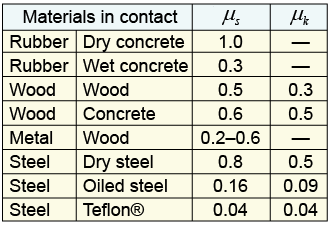|
Once an object starts moving the strength of the friction force usually drops, because it takes less force to keep surfaces sliding than it does to break them free. The coefficient of kinetic friction μk is the ratio of the force of sliding friction (or kinetic friction) to the normal force between the sliding surfaces. The subscript k in μk refers to kinetic. The table below gives some representative values for both static and kinetic friction. 
|
| (5.6) | | | Ff | = | force of kinetic friction for dry sliding (N) | | μs | = | coefficient of static friction | | FN | = | normal force (N) |
| Kinetic friction
|
|

|
 What force is needed to drag a 30 N brick across a wood table at constant speed? Brick has a surface that is similar to that of concrete, so from the table we find μk = 0.5.
What force is needed to drag a 30 N brick across a wood table at constant speed? Brick has a surface that is similar to that of concrete, so from the table we find μk = 0.5. | Asked: | friction force Ff | | Given: | μk = 0.5, FN = 30 N | | Relationships: | Ff = μkFN | | Solution: | The board will slide at constant speed when F = Ff , so Ff = (0.5)(30 N) = 15 N A force of 15 N is required. | 
|
The coefficient of kinetic friction for dry steel sliding against steel is 0.5, which is much greater than the coefficient for steel on oiled steel, which is 0.09. Lubrication is the technology of using substances such as oil to reduce friction. Oil-lubricated surfaces have much lower friction because a thin layer of oil prevents the surfaces from touching each other. Notice that the coefficient for steel sliding on Teflon® is also very low. Teflon is a special type of polymer invented by DuPont that is very slippery even when dry. Because Teflon is also chemically inert, Teflon-coated wearing surfaces are used in many artificial joints to replace injured knees and hips. 
|
Friction is both useful and wasteful. Without the friction between the soles of your shoes and the floor, you could not walk. Engineers design rubber compounds and tread patterns to provide static friction between car tires and the road even in wet or icy conditions. The brakes in your car or bicycle rely on friction to provide stopping force. Friction can also be wasteful. Only 13% of the energy from a gallon of gasoline goes into the forward kinetic energy of an average car. The remaining 87% is transformed into nearly useless heat through friction and the inefficiency of the engine. 
|

